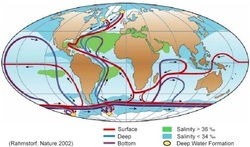
As the Gulf stream travels from the Caribbean to the Arctic circle it cools and as it does so it soaks up vast quantities of CO2 and when the cold water disappears into the deeps it takes this CO2 with it. This CO2 load has the capability to make the sea more acidic when it eventually resurfaces which would be very bad for phytoplankton, the base of the marine food chain, . The water going into the depths, although cold, is not as cold as it used to be and is consequently carrying heat into the depths of the ocean which is one way the oceans absorb 93% of the world’s heat.
Now this is the question. The Gulf Stream travels at 6.4 kilometres an hour and if the world has a circumference of 40,075 kilometres it would take 260 days to make a full circumnavigation. Clearly it does not do this but how long does it take? We know almost nothing about the current flow in the deep oceans even though we have a map of the thermohaline circulation flow.
NOAA states that it takes 1000 years for a full circumnavigation but I was under the impression it was only 14 years from sinking in the North Atlantic to surfacing in the Southern Ocean. That’s a huge disparity for a physical process that has a monumental effect on the temperature of the atmosphere and the acidity of the oceans.
It’s a question of how the water circulates. Does it stay as a current moving down valleys on the sea bed like a river or does it disperse and spread its heat and acidity throughout the oceans.
It’s not for the author. Bob Bingham to disagree with NOAA but I think it would be more like the faster option with the water surfacing after about twenty or thirty years bringing its heat and acidity back into circulation. Research is gathering pace and I suspect we will not have long to wait for more answers but at this stage your informed speculation is as good as anyone else.


 RSS Feed
RSS Feed